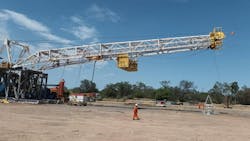Molecular Energies PLC has spudded the Tapir x-1 exploration well in the Pirity Concession in Chaco, Paraguay. The company, formerly President Energy PLC, is operator of the concession with 50% interest.
A blowout preventer (BOP) is at the drilling site in the Paraguayan Chaco, where it is being assembled, mounted, hydraulic lines installed, and function tested, the company said in a release. The well is expected to reach a depth of about 3,800 m with an estimated drilling time of 45 days.
The Los Monos formation “is the primary generator of the fold-and-thrust system in northwestern Argentina, southern Bolivia, and extends to the great Bolivian-Paraguayan Chaco,” said independent consultant Jorge Albeiro. The thickness can exceed 400 m in non-deformed areas, but in the core of structures, it can exceed 1,500 m due to tectonic stacking, due to reverse faults, he said. “Basically, it is a shale with some interesting sandy intercalations; near the base, it has high-pressure gas, which can be confused with the underlying Huamampampa formation, and in the north, that overpressured sand was known as the Terror Sandstone,” he said. Quantity and quality of organic matter “are key to any discoveries that may occur in the Paraguayan Chaco, where there is no strong tectonics,” he continued.
Albeiro suggested that the Pilcomayo River, in addition to being the geographical boundary, figuratively acts as a limit to migration. Palmar Largo field, in the Ramón Lista Department of Formosa, sits on the edge of the river, associated with the presence of a volcaniclastic complex known as Palmar Largo. The oil is associated with volcanic breccias with fracture porosity. The oil originated from levels of the Yacoraite formation rich in organic matter. This unit is in contact with the volcanic rock, and not all drilled wells have been successful. The presence of salt layers, layers with high pressure and high temperature, make wells challenging. Surubí and Selva Maria wells, about 5 km and more than 30 km from Palmar, respectively, have shown hydrocarbon indications in Yacoraite and even some production.
